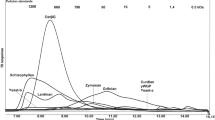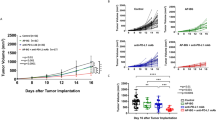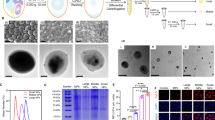Abstract
β-Glucan is a naturally occurring glucose polysaccharide with immunostimulatory activity in both infection and malignancy. β-Glucan’s antitumor effects have been attributed to the enhancement of complement receptor 3-dependent cellular cytotoxicity, as well as modulation of suppressive and stimulatory myeloid subsets, which in turn enhances antitumor T cell immunity. In the present study, we demonstrate antitumor efficacy of yeast-derived β-glucan particles (YGP) in a model of metastatic-like melanoma in the lung, through a mechanism that is independent of previously reported β-glucan-mediated antitumor pathways. Notably, efficacy is independent of adaptive immunity, but requires inflammatory monocytes. YGP-activated monocytes mediated direct cytotoxicity against tumor cells in vitro, and systemic YGP treatment upregulated inflammatory mediators, including TNFα, M-CSF, and CCL2, in the lungs. Collectively, these studies identify a novel role for inflammatory monocytes in β-glucan-mediated antitumor efficacy, and expand the understanding of how this immunomodulator can be used to generate beneficial immune responses against metastatic disease.





Similar content being viewed by others
Abbreviations
- β-Glucan:
-
β-1,3 Backbone of d-glucose with β-1,6 branches of variable length and complexity
- CR3:
-
Complement receptor 3
- DT:
-
Diphtheria toxin
- iC3b:
-
Inactivated complement component 3b
- Mφ:
-
Macrophages
- Mo:
-
Monocytes
- mHIF1α−/− :
-
Myeloid-specific knockout of HIF1α
- TII:
-
Trained innate immunity
- YGP:
-
Yeast-derived β-glucan particles
References
Aleem E (2013) β-Glucans and their applications in cancer therapy: focus on human studies. Anticancer Agents Med Chem 13:709–719
Vannucci L, Krizan J, Sima P et al (2013) Immunostimulatory properties and antitumor activities of glucans. Int J Oncol 43:357–364. https://doi.org/10.3892/ijo.2013.1974 (review)
Rahar S, Swami G, Nagpal N et al (2011) Preparation, characterization, and biological properties of β-glucans. J Adv Pharm Technol Res 2:94–103. https://doi.org/10.4103/2231-4040.82953
Chan G, Chan W, Sze D (2009) The effects of β-glucan on human immune and cancer cells. J Hematol Oncol 2:25. https://doi.org/10.1186/1756-8722-2-25
Hong F, Yan J, Baran JT et al (2004) Mechanism by which orally administered beta-1,3-glucans enhance the tumoricidal activity of antitumor monoclonal antibodies in murine tumor models. J Immunol 173:797–806. https://doi.org/10.4049/jimmunol.173.2.797
Vetvicka V, Thornton BP, Wieman TJ, Ross GD (1997) Targeting of natural killer cells to mammary carcinoma via naturally occurring tumor cell-bound iC3b and beta-glucan-primed CR3 (CD11b/CD18). J Immunol 159:599–605
Cheung N-KV, Modak S, Vickers A, Knuckles B (2002) Orally administered beta-glucans enhance anti-tumor effects of monoclonal antibodies. Cancer Immunol Immunother 51:557–564. https://doi.org/10.1007/s00262-002-0321-3
Yan J, Vetvicka V, Xia Y et al (1999) Beta-glucan, a “specific” biologic response modifier that uses antibodies to target tumors for cytotoxic recognition by leukocyte complement receptor type 3 (CD11b/CD18). J Immunol 163:3045–3052
Li B, Cai Y, Qi C et al (2010) Orally administered particulate beta-glucan modulates tumor-capturing dendritic cells and improves antitumor T-cell responses in cancer. Clin Cancer Res 16:5153–5164. https://doi.org/10.1158/1078-0432.CCR-10-0820
Liu M, Luo F, Ding C et al (2015) Dectin-1 activation by a natural product β-glucan converts immunosuppressive macrophages into an M1-like phenotype. J Immunol 195:5055–5065. https://doi.org/10.4049/jimmunol.1501158
Tian J, Ma J, Ma K et al (2013) β-Glucan enhances antitumor immune responses by regulating differentiation and function of monocytic myeloid-derived suppressor cells. Eur J Immunol 43:1220–1230. https://doi.org/10.1002/eji.201242841
Albeituni SH, Ding C, Liu M et al (2016) Yeast-derived particulate β-glucan treatment subverts the suppression of myeloid-derived suppressor cells (MDSC) by Inducing polymorphonuclear MDSC apoptosis and monocytic MDSC differentiation to APC in cancer. J Immunol 196:2167–2180. https://doi.org/10.4049/jimmunol.1501853
Osorio F, LeibundGut-Landmann S, Lochner M et al (2008) DC activated via dectin-1 convert Treg into IL-17 producers. Eur J Immunol 38:3274–3281. https://doi.org/10.1002/eji.200838950
LeibundGut-Landmann S, Osorio F, Brown GD, Reis e Sousa C (2008) Stimulation of dendritic cells via the dectin-1/Syk pathway allows priming of cytotoxic T-cell responses. Blood 112:4971–4980. https://doi.org/10.1182/blood-2008-05-158469
Netea MGG, Quintin J, van der Meer JWM, van der Meer JWM (2011) Trained immunity: a memory for innate host defense. Cell Host Microbe 9:355–361. https://doi.org/10.1016/j.chom.2011.04.006
Hohl TM, Rivera A, Lipuma L et al (2009) Inflammatory monocytes facilitate adaptive CD4 T cell responses during respiratory fungal infection. Cell Host Microbe 6:470–481. https://doi.org/10.1016/j.chom.2009.10.007
Cheng S-C, Quintin J, Cramer RA et al (2014) mTOR- and HIF-1α-mediated aerobic glycolysis as metabolic basis for trained immunity. Science 345:1250684. https://doi.org/10.1126/science.1250684
Clancy-Thompson E, Perekslis TJ, Croteau W et al (2015) Melanoma induces, and adenosine suppresses, CXCR3-cognate chemokine production and T-cell infiltration of lungs bearing metastatic-like disease. Cancer Immunol Res. https://doi.org/10.1158/2326-6066.CIR-15-0015
Cramer T, Yamanishi Y, Clausen BE et al (2003) HIF-1alpha is essential for myeloid cell-mediated inflammation. Cell 112:645–657
Clancy-Thompson E, Perekslis TJ, Croteau W et al (2015) Melanoma induces, and adenosine suppresses, CXCR3-cognate chemokine production and T-cell infiltration of lungs bearing metastatic-like disease. Cancer Immunol Res 3:956–967. https://doi.org/10.1158/2326-6066.CIR-15-0015
Huang H, Ostroff GR, Lee CK et al (2012) Relative contributions of dectin-1 and complement to immune responses to particulate β-glucans. J Immunol 189:312–317. https://doi.org/10.4049/jimmunol.1200603
Wang X, Wang W, Xu J, Le Q (2013) Effect of rapamycin and interleukin-2 on regulatory CD4+CD25+Foxp3+ T cells in mice after allogenic corneal transplantation. Transplant Proc 45:528–537. https://doi.org/10.1016/j.transproceed.2012.06.064
Bekkering S, Blok BA, Joosten LAB et al (2016) In vitro experimental model of trained innate immunity in human primary monocytes. Clin Vaccine Immunol 23:926–933. https://doi.org/10.1128/CVI.00349-16
Liu C, Yu S, Kappes J et al (2007) Expansion of spleen myeloid suppressor cells represses NK cell cytotoxicity in tumor-bearing host. Blood 109:4336–4342. https://doi.org/10.1182/blood-2006-09-046201
Butler KL, Clancy-Thompson E, Mullins DW (2017) CXCR3+ monocytes/macrophages are required for establishment of pulmonary metastases. Sci Rep 7:45593. https://doi.org/10.1038/srep45593
Sorensen MR, Pedersen SR, Lindkvist A et al (2014) Quantification of B16 melanoma cells in lungs using triplex Q-PCR—a new approach to evaluate melanoma cell metastasis and tumor control. PLoS One 9:e87831. https://doi.org/10.1371/journal.pone.0087831
Misharin AV, Morales-Nebreda L, Mutlu GM et al (2013) Flow cytometric analysis of macrophages and dendritic cell subsets in the mouse lung. Am J Respir Cell Mol Biol 49:503–510. https://doi.org/10.1165/rcmb.2013-0086MA
Hong F, Hansen RD, Yan J et al (2003) Beta-glucan functions as an adjuvant for monoclonal antibody immunotherapy by recruiting tumoricidal granulocytes as killer cells. Cancer Res 63:9023–9031
Yoon TJ, Kim TJ, Lee H et al (2008) Anti-tumor metastatic activity of β-glucan purified from mutated Saccharomyces cerevisiae. Int Immunopharmacol 8:36–42. https://doi.org/10.1016/j.intimp.2007.10.005
Ballas ZK, Buchta CM, Rosean TR et al (2013) Role of NK cell subsets in organ-specific murine melanoma metastasis. PLoS One 8:e65599. https://doi.org/10.1371/JOURNAL.PONE.0065599
Noy R, Pollard JW (2014) Tumor-associated macrophages: from mechanisms to therapy. Immunity 41:49–61. https://doi.org/10.1016/j.immuni.2014.06.010
Pommier A, Audemard A, Durand A et al (2013) Inflammatory monocytes are potent antitumor effectors controlled by regulatory CD4+ T cells. Proc Natl Acad Sci 110:13085–13090. https://doi.org/10.1073/pnas.1300314110
Vetvicka V, Vetvickova J (2015) Glucan supplementation has strong anti-melanoma effects: role of NK cells. Anticancer Res 35:5287–5292
Boring L, Gosling J, Chensue SW et al (1997) Impaired monocyte migration and reduced type 1 (Th1) cytokine responses in C–C chemokine receptor 2 knockout mice. J Clin Invest 100:2552–2561. https://doi.org/10.1172/JCI119798
Fu X, Tao L, Rivera A et al (2010) A simple and sensitive method for measuring tumor-specific T cell cytotoxicity. PLoS One 5:e11867. https://doi.org/10.1371/journal.pone.0011867
Yamamoto K, Kimura T, Sugitachi A, Matsuura N (2009) Anti-angiogenic and anti-metastatic effects of β-1,3-D-glucan purified from Hanabiratake, Sparassis crispa. Biol Pharm Bull 32:259–263. https://doi.org/10.1248/bpb.32.259
Cooper PD, Sim RB (1984) Substances that can trigger activation of the alternative pathway of complement have anti-melanoma activity in mice. Int J Cancer 33:683–687. https://doi.org/10.1002/ijc.2910330520
Qi C, Cai Y, Gunn L et al (2011) Differential pathways regulating innate and adaptive antitumor immune responses by particulate and soluble yeast-derived β-glucans. Blood 117:6825–6836. https://doi.org/10.1182/blood-2011-02-339812
Baran J, Allendorf DJ, Hong F, Ross GD (2007) Oral beta-glucan adjuvant therapy converts nonprotective Th2 response to protective Th1 cell-mediated immune response in mammary tumor-bearing mice. Folia Histochem Cytobiol 45:107–114
Netea MG, Quintin J, van der Meer JWM (2011) Trained Immunity: a memory for innate host defense. Cell Host Microbe 9:355–361. https://doi.org/10.1016/j.chom.2011.04.006
Goodridge HS, Wolf AJ, Underhill DM (2009) β-Glucan recognition by the innate immune system. Immunol Rev 230:38–50. https://doi.org/10.1111/j.1600-065X.2009.00793.x
Quintin J, Saeed S, Martens JHA et al (2012) Candida albicans infection affords protection against reinfection via functional reprogramming of monocytes. Cell Host Microbe 12:223–232. https://doi.org/10.1016/j.chom.2012.06.006
Demir G, Klein HO, Mandel-Molinas N, Tuzuner N (2007) Beta glucan induces proliferation and activation of monocytes in peripheral blood of patients with advanced breast cancer. Int Immunopharmacol 7:113–116. https://doi.org/10.1016/j.intimp.2006.08.011
Acknowledgements
We thank Brent L. Berwin, Constance E. Brinkerhoff, Marc S. Ernstoff, John Frelinger, and Irene M. Mullins for helpful suggestions and feedback. We thank Jennifer L. Vella and Yina H. Huang for assistance with B16.F10-luciferase cells.
Funding
Matthew P. Alexander was supported, in part, through the Joanna M. Nicolay Melanoma Foundation. David W. Mullins was supported, in part, through USPHS R03 CA188418. Flow cytometry and multiplex assays were carried out in DartLab, the Immune Monitoring and Flow Cytometry Shared Resource, supported by a National Cancer Institute Cancer Center Support Grant to the Norris Cotton Cancer Center (P30CA023108-37) and an Immunology COBRE Grant (P30GM103415-15) from the National Institute of General Medical Sciences.
Author information
Authors and Affiliations
Contributions
MPA performed all in vitro and mouse model studies, participated in data and statistical analyses, and contributed to the drafting of the manuscript. SNF contributed to study design and data analysis, and participated in drafting of the manuscript. GRO generated YGP β-glucan, contributed to study design and data analysis, and participated in drafting of the manuscript. RAC maintained and provided Myeloid-HIF1α−/− mice, contributed to study design and data analysis, and participated in drafting of the manuscript. DWM participated in in vitro and mouse model studies, oversaw study design and data/statistical analyses, and contributed to the drafting of the manuscript.
Corresponding author
Ethics declarations
Conflict of interest
David W. Mullins is a senior scientific advisor and has received research grants, unrelated to the current work, from Qu Biologics (Vancouver, BC). The remaining authors declare no conflict of interest.
Animal studies
C57BL/6J (stock no. 000664) and CCR2−/− mice (stock no. 004999) mice were obtained from Jackson Laboratories (Bar Harbor, ME). CCR2.DTR mice were a gift from Dr. Tobias Hohl (Memorial Sloan Kettering Cancer Center). Myeloid-HIF1α−/− mice (LysM-Cre floxed-HIF1α exon 2) were generated and bred in house at Dartmouth by Dr. Robert A. Cramer.
Ethical approval
All animal care procedures and experimental protocols were performed in accordance with all applicable international, national, and/or institutional guidelines for the care and use of animals. All animal care procedures and experimental protocols were approved by the Institutional Animal Care and Use Committee (IACUC) of Dartmouth College (protocol 1141).
Cell line authentication
B16-F10 were newly acquired from ATCC, then expanded and cryopreserved to create individual aliquots that were used for each study. B16.F10-luciferase cells were generated from new aliqouts of B16-F10. Cells were confirmed to be free of Mycoplasma infection using the Hek Blue Mycoplasma Detection Kit from Invivogen.
Electronic supplementary material
Below is the link to the electronic supplementary material.
Rights and permissions
About this article
Cite this article
Alexander, M.P., Fiering, S.N., Ostroff, G.R. et al. Beta-glucan-induced inflammatory monocytes mediate antitumor efficacy in the murine lung. Cancer Immunol Immunother 67, 1731–1742 (2018). https://doi.org/10.1007/s00262-018-2234-9
Received:
Accepted:
Published:
Issue Date:
DOI: https://doi.org/10.1007/s00262-018-2234-9




